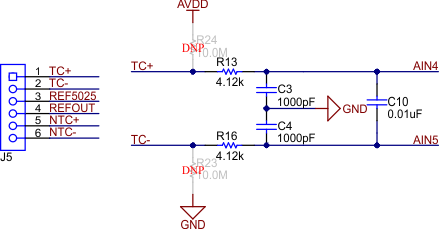SBAU378A September 2021 – January 2022 ADS1148 , ADS1248
- Trademarks
- 1Introduction
- 2Getting Started With the ADS1x48EVM
-
3ADS1x48EVM Overview
- 3.1 Analog and Digital Power Supplies
- 3.2 Voltage Reference Options
- 3.3 Clock Options
- 3.4 Digital Interface
- 3.5
Analog Input Connections
- 3.5.1 Connecting a Thermocouple to J5 on the ADS1x48EVM
- 3.5.2 Connecting a Thermistor to J5 on the ADS1x48EVM
- 3.5.3
Connecting an RTD to J6 on the ADS1x48EVM
- 3.5.3.1 Connecting a 2-Wire RTD Using a Low-Side RREF to J6 on the ADS1x48EVM
- 3.5.3.2 Connecting a 2-Wire RTD Using a High-Side RREF to J6 on the ADS1x48EVM
- 3.5.3.3 Connecting a 3-Wire RTD Using One IDAC and a Low-Side RREF to J6 on the ADS1x48EVM
- 3.5.3.4 Connecting a 3-Wire RTD Using One IDAC and a High-Side RREF to J6 on the ADS1x48EVM
- 3.5.3.5 Connecting a 3-Wire RTD Using Two IDACs and a Low-Side RREF to J6 on the ADS1x48EVM
- 3.5.3.6 Connecting a 3-Wire RTD Using Two IDACs and a High-Side RREF to J6 on the ADS1x48EVM
- 3.5.3.7 Connecting a 4-Wire RTD Using a Low-Side RREF to J6 on the ADS1x48EVM
- 3.5.3.8 Connecting a 4-Wire RTD Using a High-Side RREF to J6 on the ADS1x48EVM
- 3.5.3.9 Summary of ADS1x48EVM RTD Configuration Settings
- 3.5.4 Connecting a General-Purpose Input to J5 on the ADS1x48EVM
- 4ADS1x48EVM GUI
- 5Bill of Materials, Printed Circuit Board Layout, and Schematic
- 6Revision History
3.5.4 Connecting a General-Purpose Input to J5 on the ADS1x48EVM
Although the ADS1x48EVM is designed for measuring all types of analog temperature sensors, general-purpose input signals can be applied to the ADS1x48 through the TC± inputs on the J5 terminal block. Figure 3-21 shows the input structure used for the TC± inputs.
 Figure 3-21 Using the TC± Inputs on J5 as General-Purpose Signal Inputs
Figure 3-21 Using the TC± Inputs on J5 as General-Purpose Signal InputsAs Figure 3-21 shows, resistors R24 and R23 are not populated by default, resulting in a set of analog inputs that are only subject to the differential filter cutoff frequency of 1.93 kHz and the common-mode filter cutoff frequency of 38.63 kHz. The TC± inputs can therefore be used for any general input signal as long as the ADS1x48 absolute input and common-mode range requirements are satisfied. Select the AIN4 and AIN5 inputs on the ADS1x48 to measure a voltage connected to the TC± inputs.